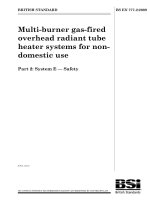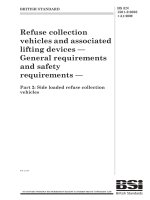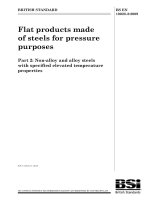Bsi bs en 61988 2 3 2009
Bạn đang xem bản rút gọn của tài liệu. Xem và tải ngay bản đầy đủ của tài liệu tại đây (1.37 MB, 28 trang )
Licensed copy: The University of Hong Kong, The University of Hong Kong, Version correct as of 24/01/2010 03:46, (c)
BSI
BS EN 61988-2-3:2009
BSI Standards Publication
Plasma display panels —
Part 2-3: Measuring methods — Image quality:
defects and degradation
NO COPYING WITHOUT BSI PERMISSION EXCEPT AS PERMITTED BY COPYRIGHT LAW
raising standards worldwide™
Licensed copy: The University of Hong Kong, The University of Hong Kong, Version correct as of 24/01/2010 03:46, (c)
BSI
BRITISH STANDARD
BS EN 61988-2-3:2009
National foreword
This British Standard is the UK implementation of EN 61988-2-3:2009. It is
identical to IEC 61988-2-3:2009.
The UK participation in its preparation was entrusted to Technical Committee
EPL/47, Semiconductors.
A list of organizations represented on this committee can be obtained on
request to its secretary.
This publication does not purport to include all the necessary provisions of a
contract. Users are responsible for its correct application.
© BSI 2010
ISBN 978 0 580 57529 7
ICS 31.260
Compliance with a British Standard cannot confer immunity from
legal obligations.
This British Standard was published under the authority of the Standards
Policy and Strategy Committee on 31 January 2010
Amendments issued since publication
Amd. No.
Date
标准分享网 www.bzfxw.com 免费下载
Text affected
Licensed copy: The University of Hong Kong, The University of Hong Kong, Version correct as of 24/01/2010 03:46, (c)
BSI
BS EN 61988-2-3:2009
EUROPEAN STANDARD
EN 61988-2-3
NORME EUROPÉENNE
EUROPÄISCHE NORM
November 2009
ICS 31.260
English version
Plasma display panels Part 2-3: Measuring methods Image quality: defects and degradation
(IEC 61988-2-3:2009)
Panneaux d'affichage à plasma Partie 2-3: Méthodes de mesure Qualité d'image: défauts
et dégradation
(CEI 61988-2-3:2009)
Plasmabildschirme Teil 2-3: Messverfahren Bildqualität: Defekte
und Bildverschlechterung
(IEC 61988-2-3:2009)
www.bzfxw.com
This European Standard was approved by CENELEC on 2009-09-01. CENELEC members are bound to comply
with the CEN/CENELEC Internal Regulations which stipulate the conditions for giving this European Standard
the status of a national standard without any alteration.
Up-to-date lists and bibliographical references concerning such national standards may be obtained on
application to the Central Secretariat or to any CENELEC member.
This European Standard exists in three official versions (English, French, German). A version in any other
language made by translation under the responsibility of a CENELEC member into its own language and notified
to the Central Secretariat has the same status as the official versions.
CENELEC members are the national electrotechnical committees of Austria, Belgium, Bulgaria, Cyprus, the
Czech Republic, Denmark, Estonia, Finland, France, Germany, Greece, Hungary, Iceland, Ireland, Italy, Latvia,
Lithuania, Luxembourg, Malta, the Netherlands, Norway, Poland, Portugal, Romania, Slovakia, Slovenia, Spain,
Sweden, Switzerland and the United Kingdom.
CENELEC
European Committee for Electrotechnical Standardization
Comité Européen de Normalisation Electrotechnique
Europäisches Komitee für Elektrotechnische Normung
Central Secretariat: Avenue Marnix 17, B - 1000 Brussels
© 2009 CENELEC -
All rights of exploitation in any form and by any means reserved worldwide for CENELEC members.
Ref. No. EN 61988-2-3:2009 E
Licensed copy: The University of Hong Kong, The University of Hong Kong, Version correct as of 24/01/2010 03:46, (c)
BSI
BS EN 61988-2-3:2009
EN 61988-2-3:2009
-2-
Foreword
The text of document 110/180/FDIS, future edition 1 of IEC 61988-2-3, prepared by IEC TC 110, Flat
panel display devices, was submitted to the IEC-CENELEC parallel vote and was approved by CENELEC
as EN 61988-2-3 on 2009-09-01.
The following dates were fixed:
– latest date by which the EN has to be implemented
at national level by publication of an identical
national standard or by endorsement
(dop)
2010-06-01
– latest date by which the national standards conflicting
with the EN have to be withdrawn
(dow)
2012-09-01
Annex ZA has been added by CENELEC.
__________
Endorsement notice
The text of the International Standard IEC 61988-2-3:2009 was approved by CENELEC as a European
Standard without any modification.
In the official version, for Bibliography, the following notes have to be added for the standards indicated:
IEC 61966-5
NOTE Harmonized as EN 61966-5:2009 (not modified).
www.bzfxw.com
IEC 61988-2-2
NOTE Harmonized as EN 61988-2-2:2003 (not modified).
__________
标准分享网 www.bzfxw.com 免费下载
Licensed copy: The University of Hong Kong, The University of Hong Kong, Version correct as of 24/01/2010 03:46, (c)
BSI
BS EN 61988-2-3:2009
-3-
EN 61988-2-3:2009
Annex ZA
(normative)
Normative references to international publications
with their corresponding European publications
The following referenced documents are indispensable for the application of this document. For dated
references, only the edition cited applies. For undated references, the latest edition of the referenced
document (including any amendments) applies.
NOTE When an international publication has been modified by common modifications, indicated by (mod), the relevant EN/HD
applies.
Publication
Year
Title
EN/HD
Year
1)
IEC 60068-1
1988
Environmental testing Part 1: General and guidance
EN 60068-1
1994
IEC 60107-1
1997
Methods of measurement on receivers for
EN 60107-1
television broadcast transmissions Part 1: General considerations Measurements at radio and video frequencies
1997
IEC 61988-1
-
Plasma display panels Part 1: Terminology and letter symbols
EN 61988-1
2003
IEC 61988-2-1
2002
Plasma display panels Part 2-1: Measuring methods - Optical
EN 61988-2-1
2002
CIE 15
2004
Colorimetry
-
-
2)
www.bzfxw.com
1)
EN 60068-1 includes A1:1992 to IEC 60068-1 + corr. October 1988.
2)
Undated reference.
3)
Valid edition at date of issue.
3)
Licensed copy: The University of Hong Kong, The University of Hong Kong, Version correct as of 24/01/2010 03:46, (c)
BSI
BS EN 61988-2-3:2009
–2–
61988-2-3 © IEC:2009
CONTENTS
1
Scope ...............................................................................................................................6
2
Normative references .......................................................................................................6
3
Terms and definitions .......................................................................................................6
4
Standard measuring conditions.........................................................................................7
4.1
4.2
4.3
5
Environmental conditions ........................................................................................7
Lighting conditions ..................................................................................................7
Set-up conditions ....................................................................................................7
4.3.1 Adjustment of PDP modules ........................................................................7
4.3.2 Warm-up condition of PDP modules ............................................................7
4.3.3 Conditions of measuring and driving equipment ...........................................7
Measuring methods ..........................................................................................................8
5.1
Cell defects .............................................................................................................8
5.1.1 Purpose.......................................................................................................8
5.1.2 Measuring equipment ..................................................................................8
5.1.3 Measuring layout .........................................................................................8
5.1.4 Division of display zone ...............................................................................8
5.1.5 Classification of cell defects ........................................................................9
5.1.6 Luminance levels of defective cells ..............................................................9
5.1.7 Measuring procedure ................................................................................. 11
5.2 Image sticking ....................................................................................................... 12
5.2.1 Purpose..................................................................................................... 12
5.2.2 Measuring equipment ................................................................................ 12
5.2.3 Specification of image sticking................................................................... 13
5.2.4 Measuring procedure ................................................................................. 13
5.3 Luminance lifetime ................................................................................................ 15
5.3.1 Purpose..................................................................................................... 15
5.3.2 Measuring equipment ................................................................................ 16
5.3.3 Measuring procedure ................................................................................. 16
Annex A (informative) Luminance lifetime estimation ........................................................... 18
www.bzfxw.com
Bibliography.......................................................................................................................... 23
Figure 1 – Measuring system and its arrangement ..................................................................8
Figure 2 – Example of display zone ........................................................................................9
Figure 3 – Dark defect on green screen and its luminance level ............................................ 10
Figure 4 – Bright defect on white screen and its luminance level........................................... 10
Figure 5 – Bright defect on black screen and its luminance level........................................... 10
Figure 6 – Bright defect on other colour screen and its luminance level ................................ 11
Figure 7 – Image sticking pattern .......................................................................................... 13
Figure 8 – Image sticking measuring position........................................................................ 14
Figure 9 – Stabilization of luminance lifetime measurement .................................................. 16
Figure 10 – Example of luminance lifetime measurement ...................................................... 17
Figure A.1 – An example of luminance degradation under different luminance
conditions ............................................................................................................................. 19
标准分享网 www.bzfxw.com 免费下载
Licensed copy: The University of Hong Kong, The University of Hong Kong, Version correct as of 24/01/2010 03:46, (c)
BSI
BS EN 61988-2-3:2009
61988-2-3 © IEC:2009
–3–
Figure A.2 – The luminance degradation on log t axis ........................................................... 19
1/2
Figure A.3 – The luminance degradation on L(t) vs. t axis (an example of straight
line) ...................................................................................................................................... 21
Figure A.4 – The luminance degradation on L(t) vs. t
1/2
axis ................................................. 21
Figure A.5 – Flow of luminance lifetime estimation................................................................ 22
Table 1 – Input signal for cell defect observation .................................................................. 12
Table 2 – An example record of cell defects.......................................................................... 12
Table 3 – Example of image sticking coefficient measurement (full screen red) .................... 15
www.bzfxw.com
Licensed copy: The University of Hong Kong, The University of Hong Kong, Version correct as of 24/01/2010 03:46, (c)
BSI
BS EN 61988-2-3:2009
–6–
61988-2-3 © IEC:2009
PLASMA DISPLAY PANELS –
Part 2-3: Measuring methods –
Image quality: defects and degradation
1
Scope
This part of IEC 61988 determines the measuring methods for defects and degradation of
colour plasma display (PDP) module in the following areas:
a) cell defects;
b) image sticking;
c) luminance lifetime.
2
Normative references
The following referenced documents are indispensable for the application of this document.
For dated references, only the edition cited applies. For undated references, the latest edition
of the referenced document (including any amendments) applies.
IEC 60068-1:1988, Environmental testing – Part 1: General and guidance
www.bzfxw.com
IEC 60107-1:1997, Methods of measurement on receivers for television broadcast
transmissions – Part 1: General considerations – Measurements at radio and video
frequencies
IEC 61988-1, Plasma display panels – Part 1: Terminology and letter symbols
IEC 61988-2-1:2002, Plasma display panels – Part 2-1: Measuring methods – Optical
CIE 15:2004, Colorimetry, 3rd Edition (ISBN 978 3 901906 33 6)
3
Terms and definitions
For the purposes of this document, most of the terms and definitions used, comply with
IEC 61988-1, IEC 60068-1 and IEC 60107-1, and the followings apply.
3.1
cell defect
cell showing a dark defect or a bright defect, or an unstable cell
3.2
defect luminance ratio
percentage of luminance difference from the full screen white-level luminance of each colour
3.3
unstable cell
cell that changes luminance in an uncontrollable way
标准分享网 www.bzfxw.com 免费下载
Licensed copy: The University of Hong Kong, The University of Hong Kong, Version correct as of 24/01/2010 03:46, (c)
BSI
BS EN 61988-2-3:2009
61988-2-3 © IEC:2009
4
–7–
Standard measuring conditions
4.1
Environmental conditions
Measurements shall be carried out under the standard environmental conditions, e.g. at a
temperature of 25 °C ± 3 °C, a relative humidity of 25 % to 85 % and pressure of 86 kPa to
106 kPa. When different environmental conditions are used, it shall be noted on the report.
4.2
Lighting conditions
The following dark-room conditions shall be used for all measurements. Illuminance shall be
less than 1 lx anywhere on the screen of the PDP module. When this illuminance significantly
affects the measurement of the black level, the background subtraction method shall be used.
In case of a different illuminance or if the background subtraction method is used, it shall be
noted on the report.
4.3
Set-up conditions
Standard set-up conditions are given below. Each condition shall be noted on the
specification form whenever any measurement is carried out under conditions that differ from
the standard set-up conditions.
4.3.1
Adjustment of PDP modules
For contrast adjustable PDP module, set the maximum contrast under the standard measuring
environmental conditions (see 4.1), measurements shall be started when the PDP module
achieves stability.
4.3.2
www.bzfxw.com
Warm-up condition of PDP modules
Measurements shall be started after warm-up when the PDP module achieves stability. The
warm-up time shall be longer than 30 min with signal input set at 15 % grey level on full
screen without gamma correction. Measurements shall be started after the above warm-up
when the PDP module achieves stability, unless other specified measuring methods are used.
When different warm-up conditions are used, they shall be noted on the report.
4.3.3
Conditions of measuring and driving equipment
a) The light measuring device shall be aligned perpendicular to the area to be measured on
the screen of the PDP module.
b) The standard measuring distance ℓ X0 is 2,5 V, where V is the screen height or the short
side length of the screen. The measuring distance shall be between 1,6 V and 2,8 V. The
measuring distance shall be noted on the report (see Figure 1).
c) The light measuring device shall be set at a proper aperture angle less than or equal to 2 °
and shall measure an area of at least 500 pixels which has an extent less than 10 % of the
screen height. This area corresponds to a circular measurement area of at least 26 lines
in diameter in the case of a display panel having a square pixel consisting of 3 subpixels.
The measuring distance and the aperture angle may be adjusted to achieve a viewing
area greater than 500 pixels which has an extent less than 10 % of the screen height if
setting the above aperture angle is difficult. Such deviations from standard conditions shall
be noted on the report.
d) The standard field frequency of the driving signal equipment shall be 60 Hz, unless the
module is intended to be used at a significantly different frequency. In any case, the field
frequency used shall be noted on the report.
e) In case of visual inspection, the inspector shall observe the area to be measured on the
screen of the colour plasma display module from the same position of light measuring
devices.
Licensed copy: The University of Hong Kong, The University of Hong Kong, Version correct as of 24/01/2010 03:46, (c)
BSI
BS EN 61988-2-3:2009
61988-2-3 © IEC:2009
–8–
Colour plasma
display module
Display surface
Light measuring device
Driving
power
source
Driving
signal
ℓX0
IEC 1242/09
Figure 1 – Measuring system and its arrangement
5
Measuring methods
5.1
5.1.1
Cell defects
Purpose
www.bzfxw.com
The purpose of this method is to measure the cell defects of the PDP modules.
5.1.2
Measuring equipment
The following equipment shall be used:
a) Driving power source
b) Driving signal equipment
c) Automatic defect inspection instrument (optional).
5.1.3
Measuring layout
Measurements shall be carried out at the standard measuring layout shown in Figure 1. When
a different measuring layout is used, this shall be noted on the report. When visual inspection
is used, the inspector should observe the module from the same place as the light measuring
equipment which is defined in the standard measuring layout.
5.1.4
Division of display zone
The whole screen is usually divided into two zones during the measurement, as shown in
Figure 2.
标准分享网 www.bzfxw.com 免费下载
Licensed copy: The University of Hong Kong, The University of Hong Kong, Version correct as of 24/01/2010 03:46, (c)
BSI
BS EN 61988-2-3:2009
61988-2-3 © IEC:2009
–9–
B-ZONE
A-ZONE
(25 %)
0,5 V
V
0,5 H
H
IEC 1243/09
Key
1
A-zone, the 25 % area of inner box
2
B-zone, the remaining 75 % area in the outer box
Figure 2 – Example of display zone
In this example, the centre of A-zone collides to the screen centre and the ratio of the size of
A-zone to that of the screen area may be defined. Figure 2 shows an example of 25 % area
and the horizontal and vertical ratio are both 0,5.
www.bzfxw.com
For the measurement of cell defects, the number of defect cells may be separately observed
on each separated screen zone as shown in Figure 2, when required in the relevant
specification.
5.1.5
Classification of cell defects
Cell defects are classified as follows: dark defect, bright defect and unstable cell.
For the definitions, see 3.3 of this standard and IEC 61988-1.
5.1.6
Luminance levels of defective cells
The luminance level for each defect on each screen condition is defined as the defect
luminance ratio X, Y, Z or V as follows:
–
A dark defect (R, G, or B) has a luminance which is darker than X % of the luminance of
full screen R, G or B respectively (see Figure 3).
–
A bright defect (R, G, or B) on white, or same colour screen has a luminance which is
brighter than Y % of the luminance of full screen R, G, or B respectively (see Figure 4).
–
A bright defect (R, G, or B) on black screen has a luminance which is brighter than Z % of
the luminance of full screen R, G or B respectively (see Figure 5).
–
A bright defect (R, G, or B) on other colours (for an example, red bright defect on full
screen green, or phosphor contamination) has a luminance which is brighter than V % of
the luminance of full screen R, G or B respectively (see Figure 6).
The X, Y, Z or V values can be different for each colour defect. The values chosen for X, Y, Z
and V shall be given in the report.
61988-2-3 © IEC:2009
R G B RG B R G B
a) Green dark defect on
green screen
R G B RG B R G B
Relative luminance (%)
– 10 –
100
X
0
Defect
levels
Luminance of
defect cell
Luminance of
full screen
green cell
b) Full screen green
c) Luminance level of
defect cell
IEC 1244/09
Figure 3 – Dark defect on green screen and its luminance level
RG B R G B R GB
Relative luminance (%)
RG B R G B R GB
Defect
levels
Y
100
www.bzfxw.com
a) Green bright defect on
white screen
0
b) Full screen green
Luminance of
full screen
green cell
c) Luminance level of
defect cell
Luminance of
defect cell
IEC 1245/09
Figure 4 – Bright defect on white screen and its luminance level
RG B R G B R G B
a) Green bright defect on
black screen
RG B R G B R G B
b) Full screen green
Relative luminance (%)
Licensed copy: The University of Hong Kong, The University of Hong Kong, Version correct as of 24/01/2010 03:46, (c)
BSI
BS EN 61988-2-3:2009
100
Defect
levels
Z
0
Luminance of
defect cell
Luminance of
full screen
green cell
c) Luminance level of
defect cell
IEC 1246/09
Figure 5 – Bright defect on black screen and its luminance level
标准分享网 www.bzfxw.com 免费下载
61988-2-3 © IEC:2009
– 11 –
RG B R G B R G B
RG B R G B R G B
a1) Green bright defect on
blue screen
RG B R G B R G B
Relative luminance (%)
Licensed copy: The University of Hong Kong, The University of Hong Kong, Version correct as of 24/01/2010 03:46, (c)
BSI
BS EN 61988-2-3:2009
b) Full screen green
100
Defect
levels
V
0
Luminance of
full screen
green cell
c) Luminance level of
defect cell
Luminance of
defect cell
Phosphor contamination
(green on blue cell)
a2) Green bright defect on
blue screen by
phosphor contamination
IEC 1247/09
Figure 6 – Bright defect on other colour screen and its luminance level
www.bzfxw.com
Peak to peak luminance variation ratio of unstable cell, W R W G W B : The peak to peak
luminance variation of an unstable cell is greater than W % of the full screen R, G and B
respectively.
The judgment whether a cell is a defect cell or not, is specified on the relevant specification.
5.1.7
Measuring procedure
Warm up the PDP module according to the procedure described in 4.3.2. The measurement
shall be performed under dark-room conditions (see 4.2.1).
Applied input signals are full screen black, full screen white, full screen red, full screen green,
and full screen blue. When different screen condition(s) are applied, they shall be reported.
Observed defect types on each screen are as follows:
–
dark defect, bright defect and unstable cell on full screen white,
–
bright defect and unstable cell on full screen black,
–
bright defect, red dark defect and unstable cell on full screen red,
–
bright defect, green dark defect and unstable cell on full screen green, and
–
bright defect, blue dark defect and unstable cell on full screen blue.
Applied signal conditions and observed defect types are summarized in Table 1.
Input one of a full screen black, white, red, green and blue signals to the module. Each signal
is described in Table 1. Observe cell defects and classify them to three types of cell defects.
Record the number of three type cell defects. Observation area on the screen may be divided
into two zones as shown in Figure 2. An input signal is changed to another signal after the
observation of the cell defects of one signal is completed.
Licensed copy: The University of Hong Kong, The University of Hong Kong, Version correct as of 24/01/2010 03:46, (c)
BSI
BS EN 61988-2-3:2009
61988-2-3 © IEC:2009
– 12 –
After the measurement of all input signals, record the total number of the defects and finish
the measurement.
The record of cell defects may be summarized as Table 2.
Table 1 – Input signal for cell defect observation
Input signal level
Signal
Observed defect of each colour (R,
G, B) a
%
Display area
Red
Green
Blue
Bright
defect
Dark
defect
Unstable
cell
Full screen
black
0
0
0
R, G, B
-
R, G, B
Full screen
Full screen
white
100
100
100
R, G, B
R, G, B
R, G, B
Full screen
Full screen red
100
0
0
R, G, B
R
R, G, B
Full screen
Full screen
green
0
100
0
R, G, B
G
R, G, B
Full screen
Full screen
blue
0
0
100
R, G, B
B
R, G, B
Full screen
a On black screen a dark defect (R, G, or B) is not observed, and a red dark defect is not observed on other
colour (G or B) screen for an example.
Table 2 – An example record of cell defects
www.bzfxw.com
Bright defect
Signal
Red
Full screen
black
1
Full screen
white
Dark defect
Green
Blue
Red
Unstable cell
Green
Blue
Red
Green
Blue
0
2
-
-
-
0
0
1
0
0
0
2
1
3
2
2
(1)
Full screen
red
0
1
0
(2)
-
-
0
0
1+(1)
Full screen
green
0
0
0
-
2+(1)
-
(1)
(1)
(2)
Full screen
blue
1
(1)
0
-
-
2+(3)
(2)
0
(1)
Total
2
1
2
2
3
5
2
2
2
NOTE
The number in brackets is the count of previously measured same defects.
5.2
Image sticking
5.2.1
Purpose
The purpose of this method is to measure the image sticking of the PDP modules. We shall
consider both the luminance and colour change during the measurement.
5.2.2
Measuring equipment
The following equipment shall be used:
a) driving power source;
b) driving signal equipment;
c) light measuring device.
标准分享网 www.bzfxw.com 免费下载
61988-2-3 © IEC:2009
5.2.3
– 13 –
Specification of image sticking
Image sticking is a general term that refers to a burned-in image, a ghost image or an image
that decays slowly over time. This is measured after operating the PDP module for 1 h with a
full white screen. See IEC 61988-1.
NOTE The 1h full white screen operation avoids confusion between image sticking and short term image retention
that disappears quickly.
5.2.4
Measuring procedure
The PDP module shall be set in the standard measuring conditions and in the dark-room
conditions. The layout diagram is shown in Figure 1.
Apply full screen white signal of level 100 % to the PDP module for 1 h, measure the initial
luminance values and the initial chromaticity values at the measuring points P 0 to P 4 as
shown in Figure 8, and then change to full screen red, green and blue in turn to measure the
initial luminance values and the initial chromaticity values at the measuring points P 0 to P 4 as
shown in Figure 8. Warm-up of the PDP module is not required here.
Apply white signal (H/5 . V/5) of level 100 % to the PDP module and maintain for the following
selected time (8, 12, 24, 36, 48) hours (should be noted) in the standard measuring condition,
the display pattern is shown in Figure 7. Afterwards, turn the PDP module power off and
maintain for 1 h in the standard measuring condition.
2V/5
www.bzfxw.com
V/5
V
Licensed copy: The University of Hong Kong, The University of Hong Kong, Version correct as of 24/01/2010 03:46, (c)
BSI
BS EN 61988-2-3:2009
2H/5
H/5
H
IEC 1248/09
Figure 7 – Image sticking pattern
Apply full white signal of level 100 % to the PDP module for 1 h in the standard measuring
condition, measure the final luminance values and the final chromaticity values at the
measuring points P 0 to P 4 as shown in Figure 8, and then change to full screen red, green
and blue in turn to measure the final luminance values and the final chromaticity values at the
measuring points P 0 to P 4 as shown in Figure 8.
Licensed copy: The University of Hong Kong, The University of Hong Kong, Version correct as of 24/01/2010 03:46, (c)
BSI
BS EN 61988-2-3:2009
61988-2-3 © IEC:2009
– 14 –
P1
P4
P0
P2
P3
V/5
H/5
IEC 1249/09
Figure 8 – Image sticking measuring position
The image sticking luminance ratio IS R ( t ), IS G ( t ), IS B ( t ) and ISW ( t ) for red, green, blue and
white are as below:
L R,P0 ( t ) / L R,av ( t )
IS R ( t ) = ( 1 – ----------------------------- -----) × 100 %
L R,P0 ( t 0 ) / L R,av ( t 0 )
www.bzfxw.com
L G,P0 ( t ) / L G,av ( t )
IS G ( t ) = ( 1 – ----------------------------- -----) × 100 %
L G,P0 ( t 0 ) / L G,av ( t 0 )
L B,P0 ( t ) / L B,av( t )
IS B ( t ) = ( 1 – ----------------------------- -----) × 100 %
L B,P0 ( t 0 ) / L B,av( t 0 )
LW,P0 ( t ) / LW,av ( t )
IS W ( t ) = ( 1 – ----------------------------- -----) × 100%
LW,P0 ( t 0 ) / L W,av ( t 0 )
where
L R,P0 ( t 0 ) is the luminance at the measuring point P0 of the full screen red before the image loading,
L R,P0 ( t ) is the luminance at the measuring point P0 of the full screen red after the image loading for a loading
period t ,
L R,av ( t 0 ) is the average luminance of 4 measuring points (P1, P2, P3 and P4) of the full screen red before the
image loading,
L R,av ( t ) is the average luminance of 4 measuring points (P1, P2, P3 and P4) of the full screen red after the image
loading for a loading period t , and t is the image loading time.
The image sticking chromatic deviation ( Δ u’(t), Δ v’(t)) R , ( Δ u’(t), Δ v’(t)) G , ( Δ u’(t), Δ v’(t)) B , and
( Δ u’(t), Δ v’(t))W at the measuring point P 0 for red, green, blue and white are as below:
( Δ u’(t), Δ v’(t)) R = (u’(t),v’(t)) R – (u’(t 0 ),v’(t 0 )) R
( Δ u’(t), Δ v’(t)) G = (u’(t),v’(t)) G – (u’(t 0 ),v’(t 0 )) G
标准分享网 www.bzfxw.com 免费下载
Licensed copy: The University of Hong Kong, The University of Hong Kong, Version correct as of 24/01/2010 03:46, (c)
BSI
BS EN 61988-2-3:2009
61988-2-3 © IEC:2009
– 15 –
( Δ u’(t), Δ v’(t)) B = (u’(t),v’(t)) B – (u’(t 0 ),v’(t 0 )) B
( Δ u’(t), Δ v’(t))W = (u’(t),v’(t)) W – (u’(t 0 ),v’(t 0 )) W
where u' and v' are CIE 1976 UCS diagram coordinates defined in CIE 15.
The values of u' and v' can be calculated from those of x and y using following equations:
u' = 4x / (3 – 2x + 12y);
v' = 9y / (3 – 2x + 12y);
where x and y are CIE 1931 chromaticity coordinates.
The measuring result should be summarized in a table. Table 3 shows an example.
When the initial chromatic non-uniformity among these points is large compared to the
chromatic difference, then the chromatic change at the measuring point P 0 shall be noted on
the report.
See IEC 61988-2-1 for optical measurement for calculating chromatic uniformity.
NOTE
The measuring method of spatial non-uniformity in IEC 61966-5 can be referred.
Table 3 – Example of image sticking coefficient measurement (full screen red)
P0
P1
P2
P3
P4
www.bzfxw.com
L R,P0 ( t 0 )
cd/m 2
L R,P0 ( t )
cd/m 2
L R,av ( t 0 )
cd/m 2
L R,av ( t )
cd/m 2
IS R ( t )
%
(x(t 0 ),y(t 0 ))
R
(x(t),y(t)) R
(u’(t 0 ),v’(t 0 ))
R
(u’(t),v’(t)) R
Initial chromatic nonuniformity (Compare
with P 0 )
( Δ u’(t), Δ v’(t)) R
5.3
5.3.1
-----------------------------------------------------------------------------
Luminance lifetime
Purpose
The purpose of this method is to measure the luminance lifetime of the PDP modules.
NOTE
During life time measurement the colour of the PDP modules may change, no adjustment needed.
61988-2-3 © IEC:2009
– 16 –
5.3.2
Measuring equipment
The following equipment shall be used:
a) driving power source;
b) driving signal equipment;
c) light measuring device.
5.3.3
Measuring procedure
The PDP module shall be set in the standard measuring conditions. The dark-room conditions
shall be applied when the luminance is measured. The layout diagram is shown in Figure 1.
Apply full screen input signal set at 15 % of white level without gamma correction or
equivalent input level when gamma correction is used. Operate the module one day under
these conditions for stabilization (see Figure 9). Measure the initial luminance for time zero at
the point P 0 as shown in Figure 8. Keep the above operating conditions and measure the
luminance of point P 0 at specified time. The specified time may be 1, 2, 5, 10, 20, 50, 100,
200, 500, 1 000 and 2 000 days.
100
Relative luminance (%)
Licensed copy: The University of Hong Kong, The University of Hong Kong, Version correct as of 24/01/2010 03:46, (c)
BSI
BS EN 61988-2-3:2009
www.bzfxw.com
0
–1 day
0
+1 day
Test start
IEC 1250/09
Figure 9 – Stabilization of luminance lifetime measurement
The luminance lifetime is the time when the luminance of the PDP module becomes 50 % of
its initial value at time zero, as shown in Figure 10.
标准分享网 www.bzfxw.com 免费下载
61988-2-3 © IEC:2009
– 17 –
100
Relative luminance (%)
Licensed copy: The University of Hong Kong, The University of Hong Kong, Version correct as of 24/01/2010 03:46, (c)
BSI
BS EN 61988-2-3:2009
50
0
0
50
Lifetime
Operating time (1 000 h)
100
IEC 1251/09
NOTE 1
Input signal of 15 % full white is estimated as the average input signal level of TV program.
NOTE 2
Chromaticity should be measured as a reference.
Figure 10 – Example of luminance lifetime measurement
In the measuring of luminance lifetime, some acceleration method may be acceptable. If any
acceleration method is applied, the acceleration condition, the acceleration ratio and the
theoretical basis of the method shall be reported.
www.bzfxw.com
Licensed copy: The University of Hong Kong, The University of Hong Kong, Version correct as of 24/01/2010 03:46, (c)
BSI
BS EN 61988-2-3:2009
– 18 –
61988-2-3 © IEC:2009
Annex A
(informative)
Luminance lifetime estimation
A.1
General
The measurement of luminance lifetime needs very long time for the reason that the
luminance lifetime usually exceeds several ten thousand hours. Acceleration method and
extrapolation method are applied to shorten the measuring period. Luminance lifetime is a
degradation phenomenon on light emitting mechanism of a PDP. Acceleration method is
applied to accelerate the degradation phenomenon under accelerating conditions.
Extrapolation method is applied to estimate the lifetime by using a degradation time formula.
Both methods are based on the knowledge of the phenomenon.
A.2
Acceleration method
Acceleration method of luminance lifetime is explained by using an example, where the
accelerating conditions of the luminance degradation of PDPs are experimentally determined
as follows:
a) luminance input level is in proportion to the speed of luminance degradation as shown in
Figure A.1 and A.2;
www.bzfxw.com
b) average temperature of the PDP has little affect on the degradation;
c) partial heating of the panel have an affect on the degradation, but the affect is very
complex and difficult to be simplified; and
d) other conditions have only a little affect on the degradation.
NOTE Accelerating conditions of each PDP module may be different, as the panel design, panel materials and
driving method are different in the module.
In this case, the acceleration may be carried under high luminance condition. Luminance
lifetime is defined as an operating time when the luminance of the PDP module reaches to the
half value of its initial value under an operating condition with a signal input of full screen
15 % white level without gamma correction and auto power control, i.e. normal operating
condition. When a signal input of full screen 60 % white level is applied without auto power
control, the luminance input level is five times larger and the luminance degradation speed is
five times faster. The measuring period of the luminance lifetime becomes one fifth of the time
under the normal operating condition.
NOTE When the affect of partial heating is clarified, window acceleration (using higher luminance window pattern,
i.e. higher acceleration condition) may be applied.
标准分享网 www.bzfxw.com 免费下载
61988-2-3 © IEC:2009
– 19 –
Increase of luminance input level
Normal operating condition
Relative luminance L(t)/L0
1
Acceleration condition
0
t
IEC 1252/09
Key
t
operating time
L(t)
luminance at t
L0
initial luminance
The speed of luminance degradation increases by luminance input levels.
Figure A.1 – An example of luminance degradation
under different luminance conditions
www.bzfxw.com
Normal operating condition
Increase of luminance
input level
1,0
Relative luminance L(t)/L0
Licensed copy: The University of Hong Kong, The University of Hong Kong, Version correct as of 24/01/2010 03:46, (c)
BSI
BS EN 61988-2-3:2009
Acceleration condition
0,5
Observed data
Acceleration factor Δ log t
0
Estimated degradation
curve obtained under
acceleration condition
Log (t)
IEC 1253/09
Key
t
operating time
L(t)
luminance at t
L0
initial luminance
The shape of luminance degradation curve under each luminance input level keeps same and moves to shorter
time region by the increase of luminance input level. Acceleration factor 10 (Δlog t) is in proportion to the ratio of
luminance input level.
Figure A.2 – Luminance degradation on log t axis
Licensed copy: The University of Hong Kong, The University of Hong Kong, Version correct as of 24/01/2010 03:46, (c)
BSI
BS EN 61988-2-3:2009
61988-2-3 © IEC:2009
– 20 –
Acceleration ratio is limited by the limit of applicable luminance input level. When an
acceleration ratio of 10 times is applied, the test period of several ten thousand hours under
normal conditions is reduced to several thousand hours. Even then the test period is too long.
An extrapolation method may be applied.
A.3
Extrapolation method
Extrapolation method may be applied, when the degradation formula is determined. Usually
degradation phenomena show exponential degradation as following:
A(t) = A 0 exp –(t/τ)
In which
t
is the operating time,
A(t) is the physical value of the degradation phenomena at time t,
A0
is the initial value of A(t), and
τ
is the constant (relaxation time).
But in the case of luminance degradation of PDPs, this formula does not coincide with the
observed result. Other formula should be chosen to apply. W. Lehman (J. Electrochem.
Soc.,130,426 ,1983) introduced following formula to the luminance degradation of fluorescent
lamps and in some cases this formula coincides with the luminance degradation of PDPs.
L(t) = L 0 exp –(t/τ)
In which
t
1/2
www.bzfxw.com
is the operating time,
L(t) is the physical value of the degradation phenomena at time t,
L 0 is the initial value of L(t), and
τ
is the constant.
In this formula, there is a linear relation between log L(t) and t 1/2 as follows;
log L(t) = –(t/τ)
1/2
+ log L 0
1/2
And the relation appears as a linear line on a log L(t) vs. t graph. Figure A.3 and Figure A.4
1/2
graphs of luminance degradation of PDPs. The relation
show examples of log L(t) vs. t
appears as a straight line or a snapped line on the graph. When the slope of the line on
longer period and /or the position of the folding are observed, the estimation of the luminance
lifetime is allowed.
Usually the time, when the luminance degradation shows the folding on the graph, is several
thousand hours in the normal lifetime measuring method. It is also too long and the
combination of acceleration method and extrapolation method are applied.
标准分享网 www.bzfxw.com 免费下载
61988-2-3 © IEC:2009
– 21 –
Observation
log L(t) /L0
0
Extrapolation
Slope
–0,3
(L/L0 = 0,5)
Luminance lifetime
t
1/2
IEC 1254/09
When the slope is determined, the lifetime estimation may be applied.
Figure A.3 – Luminance degradation on L(t) vs. t
(an example of straight line)
1/2
axis
Folding
Observation
www.bzfxw.com
0
log L(t) /L0
Licensed copy: The University of Hong Kong, The University of Hong Kong, Version correct as of 24/01/2010 03:46, (c)
BSI
BS EN 61988-2-3:2009
Slope
–0,3
Extrapolation
(L/L0 = 0,5)
Luminance lifetime
t
1/2
IEC 1255/09
When the position of the folding and the slope are determined, the lifetime estimation may be
applied.
Figure A.4 – Luminance degradation on L(t) vs. t
1/2
axis
61988-2-3 © IEC:2009
– 22 –
A.4
Estimation of luminance lifetime
In this example, at first acceleration method is applied to measure the folding and the slope of
the line on longer period. Then extrapolation is applied and the luminance lifetime is
determined as shown in Figure A.5.
Relative luminance L(t)/L0
Normal operating condition
Compare the shape
of degradation curves
and determine the
acceleration factor
of each acceleration
condition to normal
operating condition
Increase of luminance input level
1,0
Observed data
0,5
Estimated degradation
curve obtained under
acceleration condition
Acceleration factor Δ log t
0
log (t)
Plot the data on t
1/2
axis
Increase of luminance input level
www.bzfxw.com
Extrapolation is applied
and lifetime is estimated
Normal operating condition
Observed data
log L(t) /L0
Licensed copy: The University of Hong Kong, The University of Hong Kong, Version correct as of 24/01/2010 03:46, (c)
BSI
BS EN 61988-2-3:2009
0
Estimated degradation
by acceleration method
Linear extrapolation
Acceleration condition
–0,3
Luminance life
t
1/2
IEC 1256/09
Key
t
operating time
L(t)
luminance at t
L0
initial luminance
Combination of acceleration method and extrapolation method.
Figure A.5 – Flow of luminance lifetime estimation
标准分享网 www.bzfxw.com 免费下载
Licensed copy: The University of Hong Kong, The University of Hong Kong, Version correct as of 24/01/2010 03:46, (c)
BSI
BS EN 61988-2-3:2009
61988-2-3 © IEC:2009
– 23 –
Bibliography
IEC 61966-5, Multimedia systems and equipment – Colour measurement and management –
Part 5: Equipment using plasma display panels
IEC 61988-2-2:2003, Plasma display panels – Part 2-2: Measuring methods – Optoelectrical
W. Lehmann: J. Electrochem. Soc.,130, 426 (1983)
___________
www.bzfxw.com









